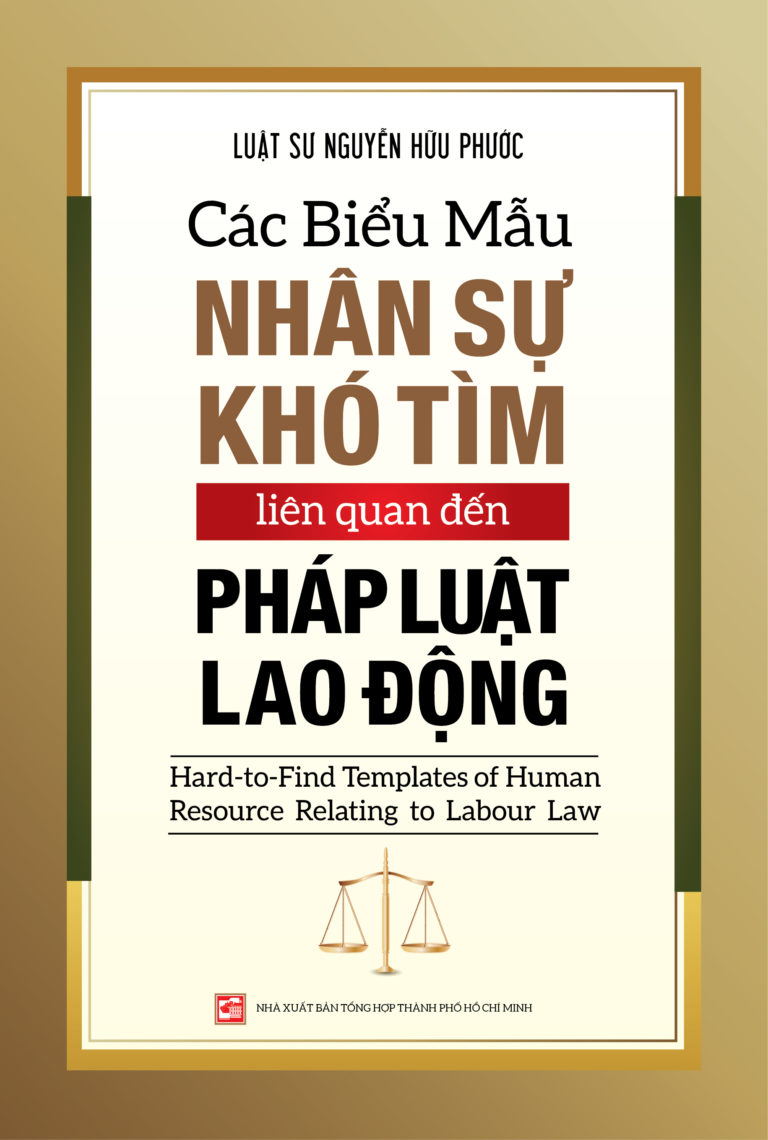Payment On Termination Of Labour Contract – How Employers Can Withhold Personal Income Tax in Vietnam
In a labour relationship, it is not always terminated in an amicable way as initially expected when expiring the contract term under agreement of both parties or when the employee has reached the retirement age according to labour law provisions. There are many cases where a labour contract is terminated prematurely under an agreement between the two parties and recognised by the labour law under Article 36.3 of the current Labour Code. The agreement to terminate the labour contract prior to expiry of its term usually originates from one of several main reasons as follows:
- The employer no longer needs to employ the employee in the original working position and cannot transfer him / her to another job in the enterprise with a lower salary or even if there is another job with equal salary, the employee does not agree to change his / her job position as it can be considered that the new job is not suitable for his / her knowledge and experience;
- Older employees are no longer suitable for the current job positions that require dynamism in a modern working environment, but the enterprise cannot cite the reason for human resource restructuring to terminate the labour contracts with them in accordance with the labour law;
- The working capacity of the employee is poor but due to his / her job position is more qualitative (secretary, receptionist, assistant, etc.) than quantitative (for example: the sales department is based on sales criterion, so it is easy to identify), so it will be difficult to use Job Descriptions and Key Performance Indicator (KPI) – the indicator of measurement and evaluation of work performance as a legal basis for unilateral termination of the labour contract due to regular failure of the employee to perform the work in accordance with the terms of the labour contract;
- The employee commits serious violations of behavioural or moral rules, such as sexual harassment with colleagues in the enterprise. The violation cannot be to the extent that he / she must be disciplined in the form of dismissal in accordance with Vietnamese labour law, but it must result in there being no longer a possibility for him / her to continue working under the internal regulations of the enterprise; or
- the employee usually fails to abide strictly, criticises the orders of senior colleagues, or has a discordant relationship with colleagues that both sides cannot resolve.
In order to arrive to an agreement to terminate the labour contract prior to expiry of its term and also because the employee will not receive severance allowance when he / she retires as in most cases job loss insurance is monthly paid in full, the employer usually has to pay him / her a certain amount of money for the following main purposes: to compensate the employee for the non-payment of severance allowance; to compensate him / her for the early termination of the labour contract; to support the employee reasonable expenses to cover living costs during the duration of search for a new suitable job; and to share with the employee the income decrease if a new job does not have the income and benefits equivalent to the current level of that of the old job.
Maybe you’re interested in: Some carelessness in unilateral termination of labour contract
Some carelessness in unilateral termination of labour contract
However, a difficult problem not only for the enterprise but also for the employee is how much compensation will be considered a reasonable amount for both parties. On the enterprise’s side, this amount should not only be appropriate for the enterprise cost budget for this issue, but also must not be significantly different between this case and other similar cases that happened before to avoid comparisons negatively impacting the equal working environment in the enterprise. On the employee’s side, the amount of such payment will depend on his / her role and position in the enterprise, the possibility of the employee to quickly find a new job suitable for his / her knowledge, and his / her experience with a reasonable salary.
According to the current reality of labour market, the financial support level will normally range from one to two months of contractual salary for each working year but in no case will be less than two months of contractual salary.
A particular level of one month, one and a half months, or two months of contractual salary will depend on the bargaining power of each party and often the parties will use some criterions such as: whether the labour contract of the employee is a definite or indefinite term labour contract (an indefinite term contract will be compensated more as there is no time limit by law to terminate the labour contract), whether the employee is nearing retirement age (if he / she is nearing retirement age, the payment will be lower as at the time of retirement, the employer is entitled to terminate the labour relationship), and the position and role of the employee in the enterprise (the higher and more valuable role and position, the higher amount of the compensation).
There are also some cases where if termination of the labour contract occurs in the middle of a financial year of the enterprise, the employee sometimes requests the employer to pay bonuses based on his / her working performance. This could include employers being obligated for the entire calendar year to provide benefits that would otherwise have been enjoyed by the employee if he / she continued working at the enterprise, such as membership cards for health and fitness clubs, school fees for his / her children, transportation means, health insurance, social insurance, etc.
After closing the amount of money that the employee will receive when agreeing to terminate the labour contract prior to expiry of its term, another equally contentious issue is that the employer must identify the amount of personal income tax to be withheld according to the progressive tax rates (the greater the income, the higher the tax payment, from the rates of 5% – 35%) or the flat tax rate of 10% on that payment.
If the income from salary of the employee as agreed in the labour contract is net income after withholding the personal income tax and compulsory insurances, the employee will not care about the amount of personal income tax to be withheld as the employer will bear this tax.
However, if this income is before tax and compulsory insurances, the employee of course bears the personal income tax from this additional income, and the employer is obligated to withhold the tax before paying this income and must provide tax withholding receipt for the employee to make year-end tax finalisation with the tax office in the locality where the employee resides (because the employee has two income sources or more from wages and salaries).
The difficult question here is whether the employer will withhold the personal income tax at the flat rate of 10%, or with progressive tax rates from 5% to 35% depending on each income level. In most cases, the 10% flat tax rate will usually be lower than the progressive tax rates as the employee whom the employer wants to terminate the labour contract with are usually at the manager position who earns a relatively high income in comparison to the general income level.
However, there are opinions that the tax withholding as mentioned here is only temporary as at the beginning of the following calendar year, the employee must also aggregate his / her incomes through wages and salaries from different sources and have his / her tax finalisation at the local tax authority where he / she regularly resides.
The payment related to termination of the labour contract is also subject to the progressive tax rates for its nature of wages and salaries. In fact, there are many cases for employees, especially those registering their permanent residences in provinces far from where they work, where they do not often want to have their tax finalisation at the local tax authorities where their permanent residences are registered.
There is no way to find out whether these employees are having different incomes through wages and salaries paid by many sources so as to force them to carry out their tax finalisation to the local tax authorities, as well as be subject to administrative fines for violation of tax laws. Therefore, many employees tend to ask their employers to withhold 10% flat tax rate of the additional payment instead of the progressive tax rates.
However, from the enterprise’s perspective, as an authorised withholding organisation under tax laws, it is responsible for withholding and paying personal income tax to the State on behalf of its employees.
But if the tax amount it pays is incorrect or lower than the payable amount as required by tax laws, the enterprise has to pay first and will find it very difficult to claim the difference from its employees if they have left elsewhere and cannot be contacted.
Employers can try contacting the employees, but this may elicit a response that they have no money to pay back or deny doing so. The money is also far from being easily recoverable if the employees deny paying it back, as a lengthy lawsuit at the competent court and following enforcement procedures to execute the court judgment that the enterprise could face, while the enterprise is being chased after by the local tax authorities for payment of the difference between the withheld tax amount and the tax amount as determined by the local tax authorities plus late payment interest, and even an administrative fine for violation of tax laws.
0Therefore, to diminish the tax risk for the enterprise, the enterprise often determines the withheld tax amount to be at the progressive tax rates. If any employee challenges this, the employer could promise that later on in case the tax finalisation inspectors apply the flat tax rate of 10%, the enterprise will return any over-paid tax amount to the employee after receiving it from the State Treasury.
Therefore, which tax rate of withholding to apply is a regular headache for many human resource officers in enterprises, especially those who do not have much experience in this regard. The employee may deny signing a termination agreement of the labour contract if the employer applies the progressive tax rates to the amount of compensation they receive. If the enterprise wants the employee to quit his / her job as soon as possible to lessen the burden of paying salary and only applies the 10% flat tax rate at the employee’s request, in case of tax finalisation inspection as the tax authority requires it to apply the progressive tax rates, the enterprise would find no easy way to recover the difference from its ex-employee.
No regulation so far provides detailed instruction on this matter, creating many misunderstandings on ways in which tax withholding should apply. To clarify this matter, some give their arguments after researching current regulations and observing their own experience in working with local tax authorities later on.
The most important thing to be considered is the compensation package paid before or after termination of labour contract. The effective point of time of the agreement on termination of the labour contract is the solid ground for determining as to whether this compensation package should be regarded as salary or wage and a part of the employment relationship. Accordingly, there are two scenarios as below:
Firstly, if this compensation package is paid after termination of labour contract, the 10% flat tax rate is acceptable as the payment has occurred when the employment relationship no longer exists, meaning the labour contract has also ceased to exist. At that time, this compensation package is considered to be no longer salary or wage under the labour contract. In accordance to Article 25.1.i of Circular 111 dated 15 September 2018 of the Ministry of Finance, guiding the implementation of the Law on Personal Income Tax (“Circular 111“), the enterprise will apply the 10% flat tax rate.
Secondly, on the other hand, if this compensation package is paid before termination of the labour contract (usually as the agreement on termination of the labour contract comes into effect), it occurs when the contracting parties still maintain their employment relationship.
Although the nature of this compensation package is only financial support after the employee stops working for the enterprise, it is unreasonable to classify it as so when the employee does not really stop working. Therefore, this compensation package is still considered to be salary or wage and subject to tax withholding in accordance with the progressive tax rates.
Accordingly, the enterprise will aggregate it with other items of salaries and wages to carry out withholding tax following the progressive tax rates before paying them to the employee. In addition, to consolidate this argument, as mentioned above, in such cases the employee often pays monthly contributions to unemployment insurance fund so the severance allowance will not be paid or is paid too little.
Therefore, this compensation package turns out to be a kind of severance allowance which is higher than the amount as required by the current Labour Laws and Social Insurance Laws. Point 11, Article 2.2.b of Circular 111 prescribes a list of incomes from salaries and wages; any amount higher than the standard salary and wage must also be regarded as salary and wage. In combination with Article 25.1.b of this Circular, is can conclude that this compensation package is considered to be income from salaries and wages, so the progressive tax rates should apply.
In addition, there are some possible cases in which the contracting parties have agreed on their termination agreement and that the payment for this compensation package would be carried out as the labour contact was still in effect.
However, for certain reasons the payment is only completed after the labour contract being terminated. In another situation, how should the withholding tax be applied when they agree that the compensation package would be paid after signing the termination agreement, but the employer has transferred such amount to the employee before terminating the labour contract? Should the method of tax to be withheld be based on the date of money transfer or should it be the date as stated in the termination agreement?
Therefore, this requires detailed guidance from the highest-level tax authority, providing a joint understanding on such a matter as compensation package is a common payment to the employee when terminating the labour contract. This needs to be clarified soon in order for employers and employees to know what to do.
However, it should be noted that the personal income tax as mentioned above is only an amount of tax withheld by the enterprise for the employee and this is a temporary tax amount that the employee must pay to the local tax authority.
The actual amount of tax payable will be calculated at the time of tax finalisation at the end of the calendar year for each individual at the local tax office. According to current regulations (Article 7.2 of Circular 111) and in consultation with the Ho Chi Minh City Tax Department’s officials on a no name basis, the personal income tax which is finalised as income from salary and wage of each calendar year will be calculated pursuant to the progressive tax rates based on withholding receipts and tax declaration of the taxable entity.
Therefore, even if the income is withheld at the 10% flat tax rate but due to its nature of income from wage and salary, when carrying out tax finalisation, this income will be subject to the progressive tax rates. When finalising tax with the progressive tax rates, either the additional payable tax or tax refund may occur, depending on each specific case. Thus, in all cases, the income from salary and wage is aggregated for a whole year of working even if the employee works in many different places and is calculated by the same method to avoid tax losses.










